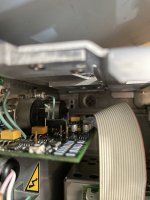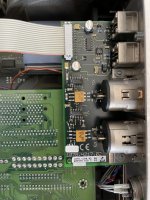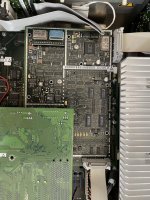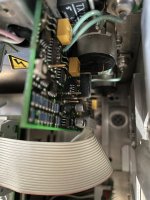I don't know if this is directed at me, but I'm don't need/want to measure loudspeaker (driver) properties. I want to measure the cross-over filter frequency response, and the equalizer frequency response. Sending in a single, mono, non-balanced output signal from the UPL into the Sonos system via a Sonos:connect, and connect the UPL inputs directly to both woofer and tweeter to see which gets what.This is the literature for loudspeaker measurements
https://cdn.rohde-schwarz.com/pws/dl_downloads/dl_application/application_notes/1ga16/1ga16_1l.pdf
However, you will need a microphone, a decent calibrator at 94/114dB and a room decent enough not to spoil the results.
But let's not hijack this thread; I have created a dedicated thread for this.
?You can measure the acoustic crossover response.
Loopback with B1 option (Low Dist Gen)
-113dB to -114dB for the UPL
-115dB on the UPV
Will do the UPD after I exchange all dying parts
Not having realtime FFT monitoring on the older APs is a deal breaker. Plus prohibitve prices for cumbersome to use machines.
My UPV is on for several hours a day, pretty much every day. It's a total workhorse, whether I'm prototyping or testing production items. The DScope is handy about once a year, when I need to troubleshoot on the road. The SYS-2722 hasn't been switched on for well over a year...
Last time I checked, the analogue oscillator on the 2722 gave ~2dB lower THD+N than any of the UPVs, but it's just too clunky to be used daily. I ought to sell it. No generation of 555 is devoid of bugs, which I find unacceptable for a machine that's so expensive. If they fixed the bugs, I'd be tempted. But they haven't in all the years my friend (has several 555) has been complaining.
Gobbledegook readings <20 Hz
While setting up a routine is about a million times easier than running a macro on the 2722, when you do so, you get slightly inferior readings to what you get from DUT when tested in one-shot mode (I don't get this at all; if levels are calibrated, why?).
These are just 2 OTOH. I'm not pretending that UPV ownership is a bed of roses and it also has many foibles. But up until recently when prices went crazy, you could buy several UPVs for the price of a 555 (secondhand - at new prices the 555 is probably around twice the price, but that's irrelevant as R+S are out of the AA business).
While setting up a routine is about a million times easier than running a macro on the 2722, when you do so, you get slightly inferior readings to what you get from DUT when tested in one-shot mode (I don't get this at all; if levels are calibrated, why?).
These are just 2 OTOH. I'm not pretending that UPV ownership is a bed of roses and it also has many foibles. But up until recently when prices went crazy, you could buy several UPVs for the price of a 555 (secondhand - at new prices the 555 is probably around twice the price, but that's irrelevant as R+S are out of the AA business).
I recently picked up an unit with what seems to be 2/3 of the 96kHz digital interface, because someone rather inconsiderately swapped the front panel with that of a unit without the front panel digital jacks…!
Does anyone have some photos of the front panel digital I/O jack boards?
I’d love to be able to somehow roll my own front panel board. I guess layout shouldn’t be that critical right…?
Thanks in advance…
Does anyone have some photos of the front panel digital I/O jack boards?
I’d love to be able to somehow roll my own front panel board. I guess layout shouldn’t be that critical right…?
Thanks in advance…
Thank you! Really appreciate it.Will take some photos today.
Just a quick update on my UPL, I hope I can somehow do my little part to contribute to this treasure trove of information on this legendary instrument.
Even the story of how I picked up a UPL with the B29 option is interesting... bear with me, please
When collecting the instrument from the seller, I noticed he had an entire pile(!!!) of them at the back of the shop. I kid you not, he has at least another 10 of them in his storage. Some factory must be mass upgrading them!
So, I asked, could I have a look at them to see if they had any internal options which I would be interested to acquire. I was looking for the B1 low distortion oscillator option.
Sure, he said, go ahead.
From the photos here and my first unit I knew the location of the oscillator, so I shone my phone's flashlight through the side of all the instruments.
And lo and behold, as luck would have it, right at the bottom of the pile was a unit which had a B1! It was the only one in the stack which had it, I wonder why...
The intention was to pay the seller's asking price for the entire unit (very reasonably priced!), just extract the B1 module so he could still sell the rest of the unit as "Parts Only".
After doing an intense physical workout to retrieve the unit, I opened it up, only to find a mystery board where the digital interface sits. The front panel was still the standard part, with no digital audio jacks.
The part number on the board read "1078.4300.02". Strange I thought, Googling it doesn't produce any results. The UPL user manual states part number 1078.4000.02 for the UPL-B2 and 1078.5107.02 for the UPL-B29. It however had the Sync and Ref sockets on the back of the board, so I didn't think it was the UPL16.
In any case, it was a much newer unit (~2004 vintage) than mine (~2000), with the small CPU board and a power supply which was in better condition, so I took the entire instrument anyway.
When I got back, I quickly realized why the unit had the digital board but no digital jacks... the signs were that the display, keyboard and floppy connector were all disconnected. Someone had swapped out the front panel for one without the digital output, but left the rest of the instrument intact! This was confirmed by plugging the display into my working unit, to be greeted with a blank, black screen. I would later find out that the backlight was completely broken (literally, the CFL tube had turned to dust) and the LCD was not working as well.
Even the story of how I picked up a UPL with the B29 option is interesting... bear with me, please
When collecting the instrument from the seller, I noticed he had an entire pile(!!!) of them at the back of the shop. I kid you not, he has at least another 10 of them in his storage. Some factory must be mass upgrading them!
So, I asked, could I have a look at them to see if they had any internal options which I would be interested to acquire. I was looking for the B1 low distortion oscillator option.
Sure, he said, go ahead.
From the photos here and my first unit I knew the location of the oscillator, so I shone my phone's flashlight through the side of all the instruments.
And lo and behold, as luck would have it, right at the bottom of the pile was a unit which had a B1! It was the only one in the stack which had it, I wonder why...
The intention was to pay the seller's asking price for the entire unit (very reasonably priced!), just extract the B1 module so he could still sell the rest of the unit as "Parts Only".
After doing an intense physical workout to retrieve the unit, I opened it up, only to find a mystery board where the digital interface sits. The front panel was still the standard part, with no digital audio jacks.
The part number on the board read "1078.4300.02". Strange I thought, Googling it doesn't produce any results. The UPL user manual states part number 1078.4000.02 for the UPL-B2 and 1078.5107.02 for the UPL-B29. It however had the Sync and Ref sockets on the back of the board, so I didn't think it was the UPL16.
In any case, it was a much newer unit (~2004 vintage) than mine (~2000), with the small CPU board and a power supply which was in better condition, so I took the entire instrument anyway.
When I got back, I quickly realized why the unit had the digital board but no digital jacks... the signs were that the display, keyboard and floppy connector were all disconnected. Someone had swapped out the front panel for one without the digital output, but left the rest of the instrument intact! This was confirmed by plugging the display into my working unit, to be greeted with a blank, black screen. I would later find out that the backlight was completely broken (literally, the CFL tube had turned to dust) and the LCD was not working as well.
I could find no other information about the B2 or B29 on the 'net, but I noticed that the board layout and components were not quite the same as that in the service manual posted here.
However, I did spot 2 CS8413 AES interfaces on the board, that I knew were good for 96kHz. Could it be...?
I set out to determine how to make the instrument detect the board... studying the schematics of the AES board (page 234 of Volume 2 onwards), I saw a 74HCT165 (D38), which looked like it was how the instrument identifies the board (no pesky EEPROMs here!). It looks like the UPL software sends an ID command through the serial bus into these shift registers, which will then spit back the version number (somehow...) via the binary code present at their inputs.
Furthermore, I saw the FP_DATA_OUT signal, that was kinda the Eureka moment. It goes to the front panel! With a missing front panel, perhaps the shift registers were not getting clocked, therefore the instrument would not detect the board. Further analysis of the front panel board schematics gave even more hope that it just needed the correct number of shift registers to be present.
It was still not a given though, as I would not know if the B29 option would have a different front panel board (again, zero information on the Internet).
Well, why not give it what it's looking for? I decided to build the part of the front I/O board around D24, D25 (74HC4094 shift registers) and D54 (74HC153 multiplexer) as I saw the possibility of the internal loopback of the AES signal.
A quick (well not really, it's still a 1+ hour round trip not including shopping time) trip to the local electronics market and about 2 hours of point to point soldering on perfboard later, and... well you can see the photos
The digital board sprang to life, version 2.16! It was also detected as a B29 Dig96 option! How about that. Even passes all self tests and if I select internal loopback, everything seems to work.
Now to really recreate the rest of the digital I/O board... the parts are still more or less available from China, let's hope they're legit.
I've also included photos of the B29 board, just in case anyone wants to reference them.
Sorry for the excruciatingly long post, I hope this helps with anyone else who wants to know more about this lovely instrument!
R&S UPL Option B29
However, I did spot 2 CS8413 AES interfaces on the board, that I knew were good for 96kHz. Could it be...?
I set out to determine how to make the instrument detect the board... studying the schematics of the AES board (page 234 of Volume 2 onwards), I saw a 74HCT165 (D38), which looked like it was how the instrument identifies the board (no pesky EEPROMs here!). It looks like the UPL software sends an ID command through the serial bus into these shift registers, which will then spit back the version number (somehow...) via the binary code present at their inputs.
Furthermore, I saw the FP_DATA_OUT signal, that was kinda the Eureka moment. It goes to the front panel! With a missing front panel, perhaps the shift registers were not getting clocked, therefore the instrument would not detect the board. Further analysis of the front panel board schematics gave even more hope that it just needed the correct number of shift registers to be present.
It was still not a given though, as I would not know if the B29 option would have a different front panel board (again, zero information on the Internet).
Well, why not give it what it's looking for? I decided to build the part of the front I/O board around D24, D25 (74HC4094 shift registers) and D54 (74HC153 multiplexer) as I saw the possibility of the internal loopback of the AES signal.
A quick (well not really, it's still a 1+ hour round trip not including shopping time) trip to the local electronics market and about 2 hours of point to point soldering on perfboard later, and... well you can see the photos
The digital board sprang to life, version 2.16! It was also detected as a B29 Dig96 option! How about that. Even passes all self tests and if I select internal loopback, everything seems to work.
Now to really recreate the rest of the digital I/O board... the parts are still more or less available from China, let's hope they're legit.
I've also included photos of the B29 board, just in case anyone wants to reference them.
Sorry for the excruciatingly long post, I hope this helps with anyone else who wants to know more about this lovely instrument!
R&S UPL Option B29
Thanks for the photosLong delay.
Thought I had one dissasembled.
Are you able to see if the ground plane is split under the CLC430 chips?
Hi,
I used to think DOS network will not be able to coexist with UPD control software due to memory shortage (DOS limitation!), but it doesn't! Now I can view UPD's storage from win10 PC while UPD measurement is running.
Although using win9x or WFW3.11 is also able to do that, plain DOS is faster to boot and just playing with DOS was fun.
IIRC, later UPL also equips LAN interface on the PC board, so some UPL may also be able to use file sharing on DOS.
I have followed these DOS network instructions.
https://klsys.com/unkategorisiert/netzwerk-unter-ms-dos/https://de.wikibooks.org/wiki/FreeDOS-Kompendium:_Konfiguration:_Netzwerkhttps://forum.classic-computing.de/forum/index.php?thread/25506-dos-netzwerkzugriff-auf-windows-10/
In addition, to access DOS resources from win10 PC, networks on the explorer didn't work.
It is needed to use two steps commands, for example
net use \\dosname
net use * \\dosname\share
Just latter command didn't work, I don't know why...
Once registered the resource to win10, it will be automatically reconnected at power on.
I used to think DOS network will not be able to coexist with UPD control software due to memory shortage (DOS limitation!), but it doesn't! Now I can view UPD's storage from win10 PC while UPD measurement is running.
Although using win9x or WFW3.11 is also able to do that, plain DOS is faster to boot and just playing with DOS was fun.
IIRC, later UPL also equips LAN interface on the PC board, so some UPL may also be able to use file sharing on DOS.
I have followed these DOS network instructions.
https://klsys.com/unkategorisiert/netzwerk-unter-ms-dos/https://de.wikibooks.org/wiki/FreeDOS-Kompendium:_Konfiguration:_Netzwerkhttps://forum.classic-computing.de/forum/index.php?thread/25506-dos-netzwerkzugriff-auf-windows-10/
In addition, to access DOS resources from win10 PC, networks on the explorer didn't work.
It is needed to use two steps commands, for example
net use \\dosname
net use * \\dosname\share
Just latter command didn't work, I don't know why...
Once registered the resource to win10, it will be automatically reconnected at power on.
- Home
- Design & Build
- Equipment & Tools
- Rohde Schwarz R&S UPL Audio Analyzer Renovation



